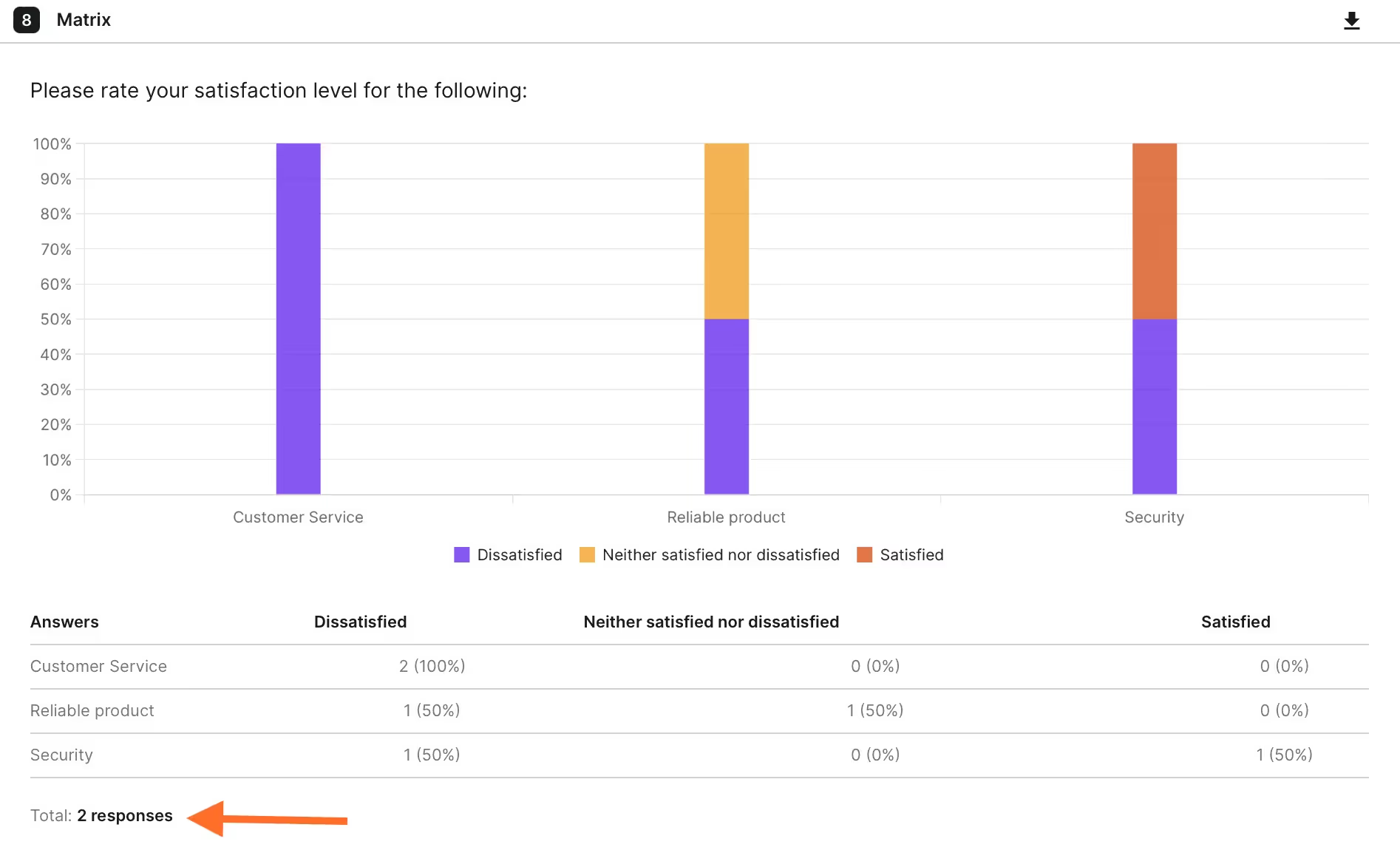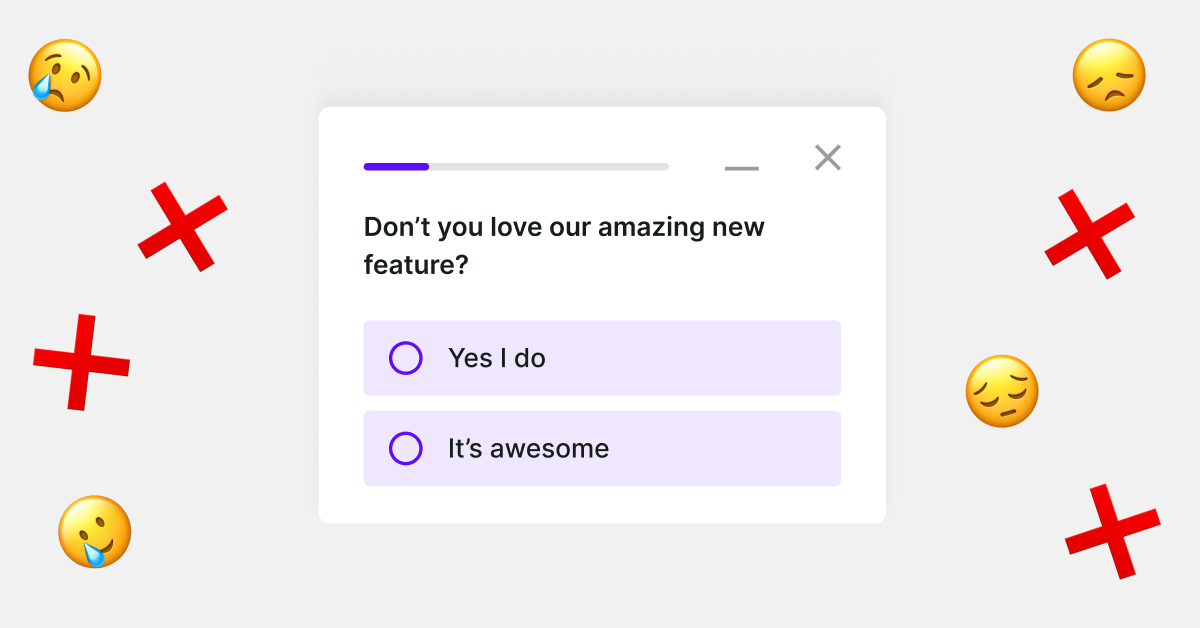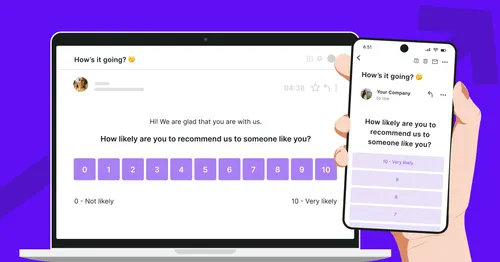Are you having trouble creating the perfect survey? If you're asking many questions, especially if they sound similar, your respondents may struggle with survey fatigue. This can lead to boredom, stopping in the middle of a survey, and poor-quality data.
To spice things up and improve engagement in your surveys, start with your survey questions. One popular type of question is the matrix question, which can provide amazing data insights if done correctly. Check out this guide for more tips on creating effective survey questions.

What are matrix questions?
In a survey, a matrix question is a type of closed-ended question that offers respondents a selection of multiple answers to choose from within a single question. Unlike other closed-ended questions, a matrix question comprises a series of different questions that all share the same set of answer options.
The purpose of a matrix question is to efficiently gather information from respondents about a specific topic by providing them with a comprehensive range of answer options to choose from. This approach to questioning can help to reduce survey length and increase survey response rates, as respondents can quickly provide their answers to a series of related questions.
Overall, the use of matrix questions in surveys can be an effective way to gather detailed information from respondents in a streamlined and efficient manner.
When creating a matrix question for your survey respondents, it is important to provide clear and concise answer options, such as:
- Very satisfied
- Somewhat satisfied
- Neither satisfied nor dissatisfied
- Somewhat dissatisfied
- Very dissatisfied

The aim of a matrix survey is to provide multiple matrix questions with these same answers. This makes it easier for respondents to give answers and for you, as the person running the survey, to collect qualitative and quantitative data.
A subset of matrix questions is called rating questions—which is the same thing, but the answers are given weight on a Likert scale such as in this Customer Satisfaction Score survey:
Calculating matrix survey results
Creating matrix surveys is only half of the job. To understand how you get results, you need to understand survey logic.
In short, Survicate shows answers in a bar chart for each column. To get the result, the tool divides the number of responses to a particular question by the total number of responses, and this number is then multiplied by 100. Or, in simpler terms:

You can add multiple scale points and rows and columns without fear of not being able to get survey results that are easy to interpret. Things can get a bit complex if you use multiple matrices, though, so sticking to one at a time is a good idea.
Pros of using matrix questions in surveys
Matrix questions are a superb way for survey creators to get a lot of information rapidly. They’re also quick and effortless for respondents to fill in. Let’s go through some more of the many benefits of matrix surveys.
Making a larger questionnaire simpler by dividing it into subtopics
If you have a questionnaire with a lot of survey questions, you’re going to run into some issues such as survey fatigue, inevitably. Keeping the matrix survey questions organized is one of the easiest ways to ensure a superior user experience and boost your survey completion and response rates by saving space in the survey.
A matrix question lets you easily group questions into segments with the same answer choices. Not only does it make it easy for respondents to complete the survey, but it also shortens the time spent creating them.
Making it easier for respondents to answer lots of rating-scale questions
A few matrix questions in a survey are a good idea. But having a whole bunch of them really kills the survey experience and makes the question list looks cluttered. More importantly, it puts the respondents off.
If you have a few rating scale questions, adding matrix questions is a neat way to show them one after the other without making your survey look cluttered. This leads us to our next point.
Increasing survey completion rates
Looking to boost your matrix survey completion rate? Matrix questions help you line up a range of similar questions and answers without overwhelming the respondents. In the end, you’ll get better engagement and higher competition rates.
Cons of using matrix questions in surveys
While they are incredibly effective at getting lots of qualitative and quantitative data from your customers, matrix questions are not flawless. In fact, if you use them often, you should be aware of some of their downsides.
A risk of "lazy" survey filling
The biggest advantage of matrix questions can also be its biggest flaw. These questions can be answered extremely quickly—with just a few clicks, your respondent can answer a dozen questions.
However, many participants might rush through the surveys, clicking away randomly and skewing your results. Others might answer all questions using the same response, in a process called straight-lining. Some people can even create patterns in their answers for fun.
Last but not least, matrix questions can even be filled in by bots. If you offer financial incentives to respondents who take your surveys, some of them might use bots to do the job. This rigs the results and, to make matters worse, you might also spend lots of money on these useless responses.
It’s a good idea to look through your matrix survey responses manually from time to time, just to make sure your data is accurate for each specific scale point and question.
Challenge of displaying matrix questions on mobile devices
The entire point of matrix questions is to show many answer choices for a single question, which works well on laptops, desktop computer screens, and even on paper. However, things are not so simple with mobile devices when you don’t have as much real estate to work with.
Usually, this would be a challenge, but thanks to survey software such as Survicate, matrix questions can look great even on mobile devices.
When used in the wrong way, they might overwhelm your respondents
Survey fatigue is real. It happens when your respondents either get too many surveys or survey questions in a short time. Some effects include the following: your completion rates drop, you get poor-quality data, and your respondent might even ignore your emails in the future.
This is why it’s crucial to use matrix questions sparingly and only when you can truly benefit from having them in a survey. Moreover, make sure to pace your surveys so your respondents don’t feel overwhelmed.
Survicate can help you prevent clutter in your survey in at least one way—you can’t have too many rows and columns. The maximum in Survicate is 13 rows and 7 columns.
Of course, you should aim for fewer questions in a matrix survey, but this is a good guideline so your audience doesn’t lose interest.
Matrix questions examples for your survey
Creating matrix questions is not difficult, and the beauty of this question type is that you can use it in many different kinds of surveys. Now, let’s look at a few different types of matrix questions as well as when and how to use them for the best effect.
If you, for instance, run a hotel, you might want to ask your guests the following question:
Please rate your most recent experience with us:
Fully satisfactory
Somewhat satisfactory
Neither satisfactory nor dissatisfactory
Somewhat dissatisfactory
Fully dissatisfactory
You want to use these questions when it’s important to capture specific, accurate feedback and pinpoint customer sentiments in a condensed way.
How often do you use our products at work?
Every day
Often
Sometimes
Hardly ever
Never
Once the results come in, you can analyze them in the Survicate dashboard:

For each question, you get a breakdown that includes the total number of respondents and the number of people who selected a particular answer.
Here’s another multiple-selection matrix question type that you can easily adjust to any survey type:
To what extent do you identify with the following statements?
I go to the cinema occasionally
I’ve never been to the cinema
I don’t mind going to the cinema once in a while
I prefer watching movies at home
And example answers:
I definitely agree
I agree
I don’t know
I don’t agree
I definitely don’t agree

Mistakes to avoid with matrix questions in surveys
As with every survey type, mistakes sometimes pop up in matrix questions. Here are some of the most common ones you should be aware of.
Too many possible answers = poor responses
Too many responses in a matrix question is a thing. If you have more than a handful of possible answers, your respondents may react unfavorably.
Or, in simpler terms, they’ll see all those rows and columns and simply leave. Ideally, you want to keep the number of predefined answer sets under 5 for the highest survey completion rates and the best data quality. If possible, avoid using multiple matrices and stick to one per survey.
Adding complicated instructions
The survey experience should be as simple and smooth as possible for your respondents, which is where matrix questions differ from standard questions, as you can use them for this purpose.
If you complicate the instructions for answering matrix questions, say goodbye to satisfactory completion rates. A simple “rate your experience on a scale from 1-5 with 1 being completely dissatisfied and 5 being completely satisfied” is going to fit the bill.
Combining and blending various topics
Once again, simplicity is the name of the game with this question type. One way to ensure better engagement in your surveys is to keep the questions and answers aligned and stick to a particular topic.
For example, if you’re asking customers to rate their experience with various aspects of your hotel, you don’t want to suddenly introduce questions on the booking process. Avoid jumping to different categories for the questions as well as the response options to keep the survey-taking experience foolproof.
Create a perfect matrix question survey with Survicate
Not even the best matrix questions can save you if your surveys look bad, don’t work well on mobile devices, or don’t send the right information to your CRM or helpdesk tool.
In short, matrix questions need the right setting to work at their best. You need a survey tool to make it all click, and you need Survicate.
We have over 400 survey templates you can use today. Just create your free account, select a survey template, add some multiple selection matrix questions, and you’re good to go. You can publish your survey on your website, send it via email, or use it on social media, to mention just a few channels available with Survicate.
Sounds like a good deal? We’d like to offer you a 10-day free trial so you can experience amazing qualitative and quantitative feedback, stellar survey competition rates, and an amazing customer experience. Your customer data is waiting for you!
You might also be interested in:













.svg)

.svg)



